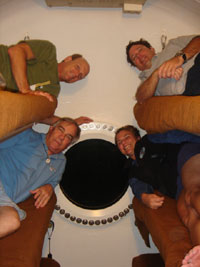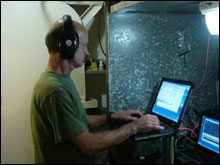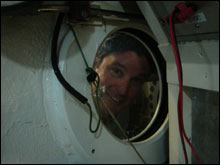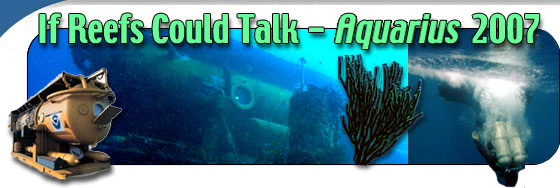Error processing SSI file
|
Mission Log: September 18, 2007
Dr. Chris Martens
Aquarius Aquanaut
 |
|
Aquanauts from top left to top right - Dr. Niels Lindquist, Dr. Chris Martens, Kate Thompson, Scott Donahue. (Photo-NOAA National Marine Sanctuary Program)
|
My students and I at UNC Chapel Hill began the semester in the normal way. We showed up at the beatiful new Stone Center on campus and started classes with our discussions about "Change in the Coastal Ocean".
During the first week of classes we discussed sea turtle navigation and read research papers by Catherine and Kenneth Lohmann, both faculty members in our Department of Biology. About the time that our class was visiting the live juvenile turtles at the Lohmann's house in their laboratory, I was in full training to become an Aquarius Aquanaut. Best of all, by the next week I was living in Aquarius and teaching my class while out on Conch Reef, located about four miles out from Key Largo on the Florida Reef tract.
The classes were able to make a virtual visit because I was diving with a "superlite" hard hat helmet equipped with both a camera and audio. Questions from the students were relayed out to me by Dr. Niels Lindquist who was back in the Aquarius underwater habitat.
 |
|
Dr. Niels Lindquist checks the chat room for the live show to UNC Chapel Hill. (Photo-NOAA/National Marine Sanctuary Program)
|
On Thursday, we'll reverse our roles and Niels will lecture from out on the reef. It's really important to make a direct connection between the classroom and the coastal ocean. Those of us involved in coastal ocean research are aware of apparently widespread changes in most coastal environments. In general, it is proven difficult to explain the causes for even the most obvious changes such as the shocking decline in coral reef cover in tropical environments around the world. In some cases, over-fishing or pollution happen to be important causal agents. It is extremely satisfying to be able to take students live right out to Conch Reef, where change is underway.
In addition, we are able to introduce the students to the experimental approaches that are being utilized to understand the changes. In particular, our work with in-situ mass spectrometry, on of the very first such studies in the world that is very exciting! Usually it is impossible to actually show how we are making measurements. Now we see it every few seconds right of the reef live...
 |
|
Aquanaut Scott Donahue looks through a portal between the wet porch and the entry lock. (Photo-NOAA/National Marine Sanctuary Program)
|
In my opinion, we need to place greater emphasis on exposing students to experiential learning, that is, actual involvement in the fieldwork needed to solve environmental problems. Because of the Aquarius facility, and this mission sponsored by NOAA's National Marine Sanctuary Program, the first of it's kind for the coastal ocean, we are able to accomplish both educational and scientific objectives while having lots of fun!
I grew up in South Florida and the Florida Keys. My Dad was a fisherman working out of Marathon just down the road toward Key West. I owned a small boat at the time and had a free run of the nearby ocean after school. During my youth, there were larger patches of branching coral reefs all along the outer reef tract plus a lot more fish. I hope that our shared experiences from the Aquarius Mission - If Reefs Could Talk will heighten both interest in the coastal ocean and awareness of the changes that are now occurring around us down here.
Signing off.
|



